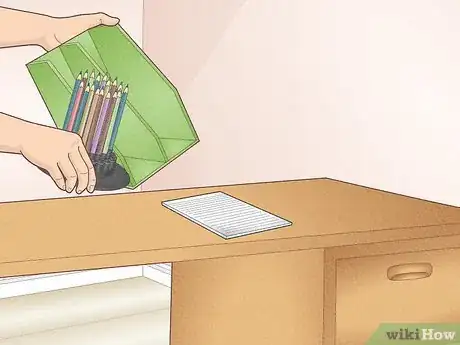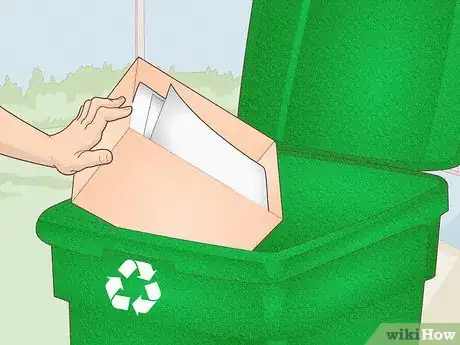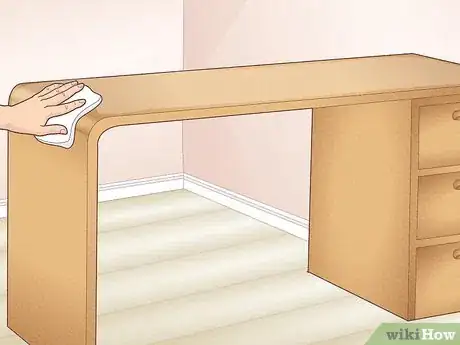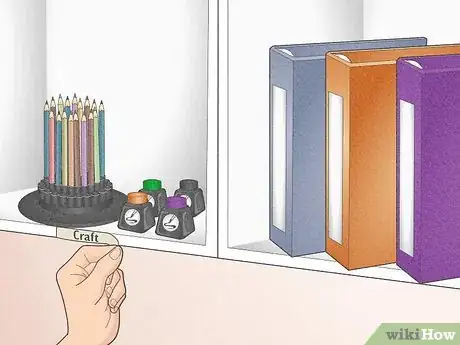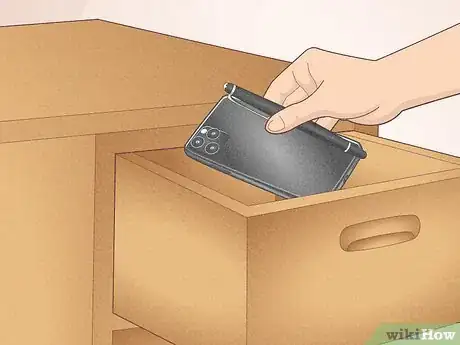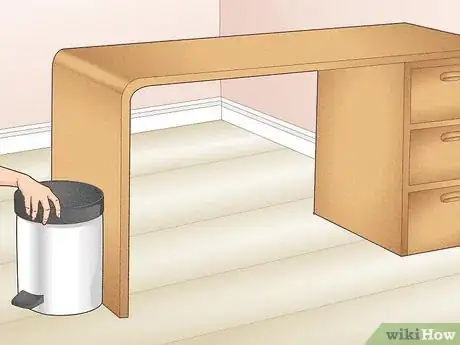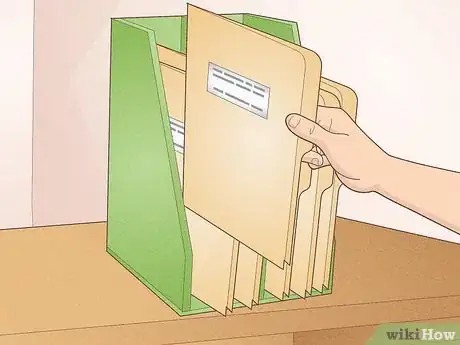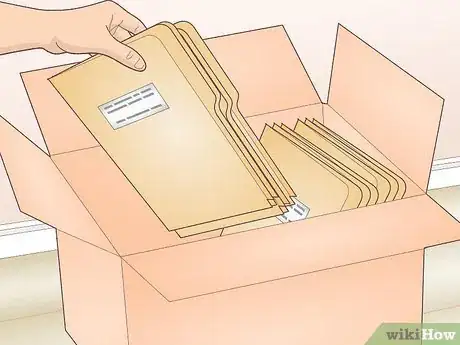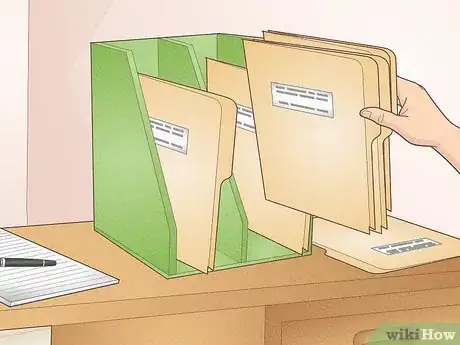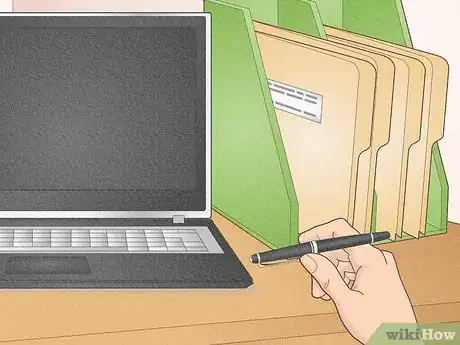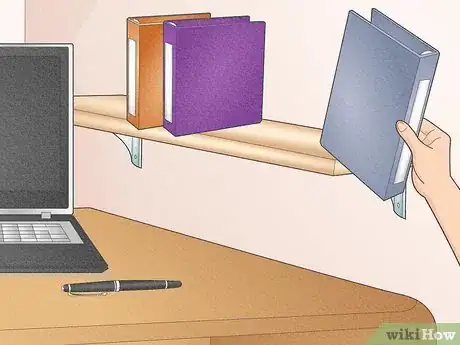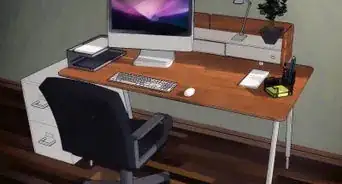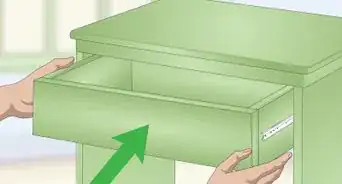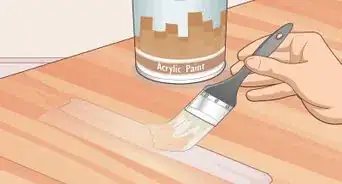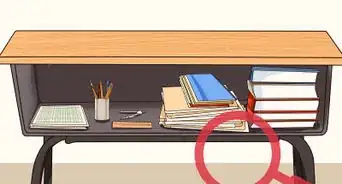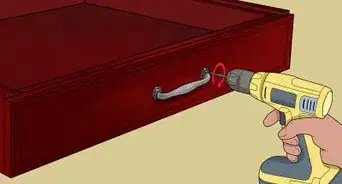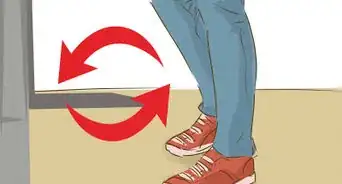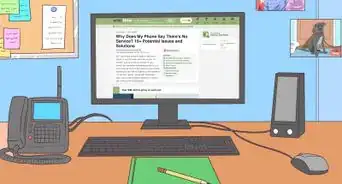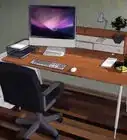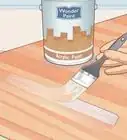This article was co-authored by Melissa Maker. Melissa Maker is host and editor of CleanMySpace, a YouTube channel and blog with over 1 million subscribers. She has over 10 years of professional cleaning experience, and dispenses helpful tips on all things home.
wikiHow marks an article as reader-approved once it receives enough positive feedback. This article received 11 testimonials and 84% of readers who voted found it helpful, earning it our reader-approved status.
This article has been viewed 260,099 times.
Many people get their most important work done at a desk. If your desk is messy or disorganized, it can be difficult to focus or to keep track of important projects, bills to pay, correspondence to answer etc. Cleaning up your desk will allow you to work more efficiently and feel more focused on your desk-based tasks. Get started at step number on below.
Steps
Clearing Your Desk
-
1Take everything off your desk. Remove absolutely everything and place it all in one large pile. When it’s time to reorganize your desk, you’ll go through this pile methodically. Don’t try to organize the contents of your desk when you remove it, you need to create some clear space first.[1]
- Make sure you remove everything from your desk, even if you know you're going to put it back in the same place. This includes pictures, plants, papers, diaries, your computer etc.
-
2Throw away trash and place recyclable items in suitable containers. Something becomes trash as soon as you don’t need it anymore. You may think that you need to save something, but be sure before you do. If you’re not sure, you can place it a spot for things that you’re not sure you’ll need.[2]
- Shred any sensitive documents before disposing of them.
- Recycle paper, plastic, and anything else that is recyclable.
- People who are extremely organized with clean desks have a saying: “When in doubt, throw it out.”
Advertisement -
3Wipe down all surfaces. Even if you think the things on your desk are pretty clean, it doesn’t hurt to give everything a once over. Clean your computer screen, dust all of the surfaces, dump out and wipe down desk drawers.[3]
- You can use compressed air to clean your keyboard or any other objects with difficult to reach areas.
- You can use a solution of water and white vinegar to clean many surfaces or purchase a cleaning agent that you like.
- Surfaces include the top of your desk, the inside of your drawers, the tops of shelves, and any screens.
Creating Organizational Systems
-
1Use shelves. You may want to build shelves into the wall or buy them, or you may already have shelves. If you put up shelves, you may want them right above your desk or on the other side of the room. This usually depends on where your desk is and what you use it for.[4]
- If your desk is in a cubicle at work, you may need to set up some small shelves above or next to your desk.
- If your desk is in a home office or bedroom, you may want your shelves away from your desk so that they’re out of sight and don’t pose a visual distraction.
- Think about what will go on the shelves before you install them. Make sure they’re the right size for the books or tools you plan to put on them.
-
2Label drawers and shelves without damaging the finish of the drawers or shelves. By labeling shelves and drawers, you are telling yourself what goes in each place. This is key for staying organized. You can make your own labels with masking tape or stickers, or you can buy more decorative labels if you prefer.
- Make sure every label is clear and specific. That way, no drawer will simply become a “junk drawer.”
- If you like, you can use a color-coding system instead of writing the words on each drawer.
- Be careful with labels. Don't generalize too much or you can end up having messy drawers full of miscellaneous items. This can also cause confusion when it's time to put something away.
-
3Make important things accessible. You know the things that you use at your desk the most often. Keep those things close by and easy to get to. For example, if you have a few vertical drawers under your desk, the top one should contain the things you’ll reach for most frequently. Alternately, you can keep crucial items on shelves that are visible and easily within reach.
- You can choose a few important things that get to sit on top of your desk. These can include current projects or tools you use repeatedly, such as a ruler or calculator.
-
4Place a trashcan nearby. This is key for not having trash pile up around your desk. Your trashcan should be reachable without getting up from your desk. That way, there’s no danger of leaving a piece of trash on your desk to clutter it up.[5]
Putting Your Desk Back Together
-
1Sort through your pile. Now you have a clean desk and a large pile of things that came off of it. Begin going through the pile from the top down. Don’t skip over anything. As you sort, remove junk and trash. Separate important things that will eventually go on shelves on in drawers.[6]
- Do whatever needs to be done with each object immediately if you can. If a paper needs to be shredded, or a knick-knack needs to be dusted, do it now. Don’t wait until later.
- If it will take more than two minutes to deal with an object (for example, if the paper shredder is in another building, or you’d need to go buy a duster) place the object on your “to do” list.
- Objects that will go back on the desk can go into a new pile. Objects that are trash go in the trash. Objects you’re not sure about can go in a third pile.
-
2Store objects you're unsure about. Take the pile of objects that aren't trash but that don't belong on your desk and put them in a box or a drawer. Store that container in a basement, a closet, or somewhere else.
- After a month, six months, or a year, you can go through that container. If you haven't used something from it, throw it away. The chances that you'll ever use it are very slim.
-
3Replace objects on the desk. Take each object from the first pile and place it on your desk or on a shelf. Use the labels you’ve created or use another organizational system. Put each item back on the desk, one thing at a time.[7]
- Try to avoid having a lot of visual distractions at your desk. Limit the amount of decoration at your desk so that you can still focus.
- Books are best kept off your desk if possible. Have an accessible shelf where you can keep the books you need regularly.[8]
-
4Clean your desk regularly. The more frequently you clean your desk, the easier it will be each time. At the end of each day, look at your desk and tidy it up. Throw away any trash and file away any stray papers or pieces of a project.[9]
- By cleaning your desk off at the end of each workday, you ensure that you’ll come into a clean and usable workplace the next day.
- Designate one day per week or month to really clean your desk thoroughly, depending on how quickly it gets messy or disorganized.
Choosing an Organizational System
-
1Organize things in a way that works for you. Everyone has a different way of organizing their desk and their tools. Yours will depend on the kind of work you do at your desk. Make sure that whatever you do, it keeps the space usable and clear of distractions.[10]
- You might want to use different kinds of containers for different items.
- You might need file folders or a bulletin board to pin things to.
- You may have lots of tools that need to be hung on hooks.
-
2Keep only relevant tools nearby. If you mostly use your desk for office work, don't keep your craft supplies there. Choose a different place in your room or office to keep those things.
- If you have noticed that a certain item rarely or never gets used, don't keep it at your desk.
- If there's a tool or resource that you use a lot but have been keeping elsewhere, create a space for it at your desk.
-
3Try new things. If you've been having a hard time staying organized or keeping your desk clean, this could be a sign that you need to create a different organizational method. If you've kept everything in drawers, maybe shelves or hooks would be better for you. If you have a hard time focusing on your computer screen, maybe you need to clear everything else out of sight.
- Ask other people who work in your field how they organize their desks. They might have valuable insights for you!
Community Q&A
-
QuestionHow can I decorate my shelf?
 KyeKye4Community AnswerYou can buy some fairy lights, paint, paper flowers, and other things to personalize the shelf just for you.
KyeKye4Community AnswerYou can buy some fairy lights, paint, paper flowers, and other things to personalize the shelf just for you. -
QuestionHow can I make my desk more interesting?
 Community AnswerYou can add some decorations or put some items on it that you like: books, a plant, candles, figurines, a vase, a clock, a globe, a little bowl to keep small items in, a nice lamp - those are just some ideas. If your desk is very basic and you have a lot of plain wall space above it, you can hang a poster, a tapestry, some pictures, a cork board or dry-erase board, and/or a calendar. Just be sure whatever you put there will not distract you from your work or take up too much space.
Community AnswerYou can add some decorations or put some items on it that you like: books, a plant, candles, figurines, a vase, a clock, a globe, a little bowl to keep small items in, a nice lamp - those are just some ideas. If your desk is very basic and you have a lot of plain wall space above it, you can hang a poster, a tapestry, some pictures, a cork board or dry-erase board, and/or a calendar. Just be sure whatever you put there will not distract you from your work or take up too much space. -
QuestionI have too many things on my desk. I can't get another shelf as I already have two very large ones filled. How do I organize my desk?
 KyeKye4Community AnswerTry getting some storage bins or drawers to store extra desk items until you have to use them.
KyeKye4Community AnswerTry getting some storage bins or drawers to store extra desk items until you have to use them.
References
- ↑ http://zenhabits.net/steps-to-permanently-clear-desk/
- ↑ http://www.gq.com/story/how-to-clean-your-desk-
- ↑ http://www.gq.com/story/how-to-clean-your-desk-
- ↑ http://www.apartmenttherapy.com/how-to-clean-your-desk-in-5-mi-148479
- ↑ https://timemanagementninja.com/2014/02/10-tips-to-keep-your-desk-clean-organized-productive/
- ↑ http://zenhabits.net/steps-to-permanently-clear-desk/
- ↑ http://www.gq.com/story/how-to-clean-your-desk-
- ↑ http://www.apartmenttherapy.com/how-to-clean-your-desk-in-5-mi-148479
- ↑ http://zenhabits.net/steps-to-permanently-clear-desk/
About This Article
Having a clean desk will help you to focus on your work and find things when you need them. Only keep things you need easy access to on your desktop and store everything else in drawers. Try using a mason jar for storing loose pens and pencils. Designate your drawers for different purposes. For example, have one drawer for stationary, another for papers and notebooks, and a third for larger items. You can make labels for your drawers with masking tape or stickers. Keep a trashcan under your desk so you can easily get rid of things you don’t need. Try to actively tidy your desk as you work so the mess doesn’t build up. For more tips from our Tidying co-author, including how to use shelves to make space on your desk, read on!
